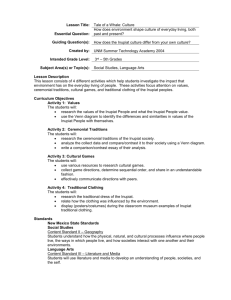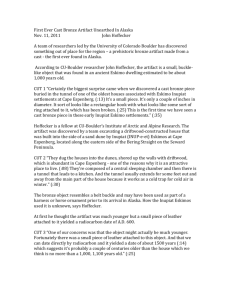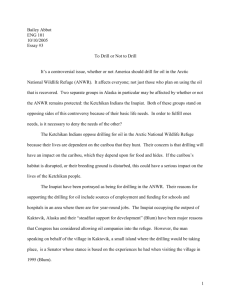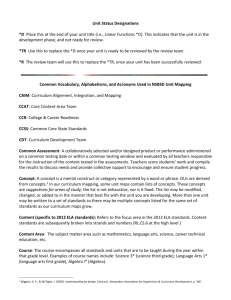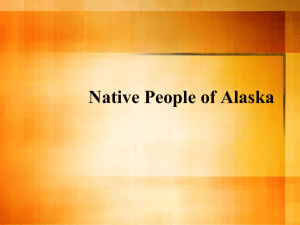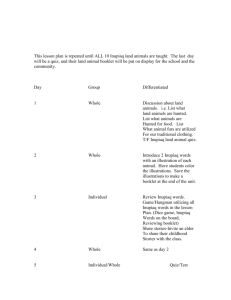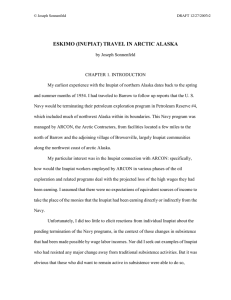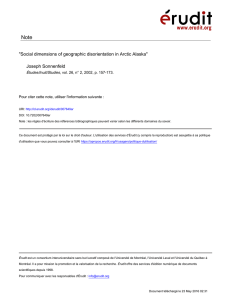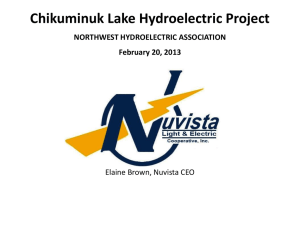Relation to Society
advertisement
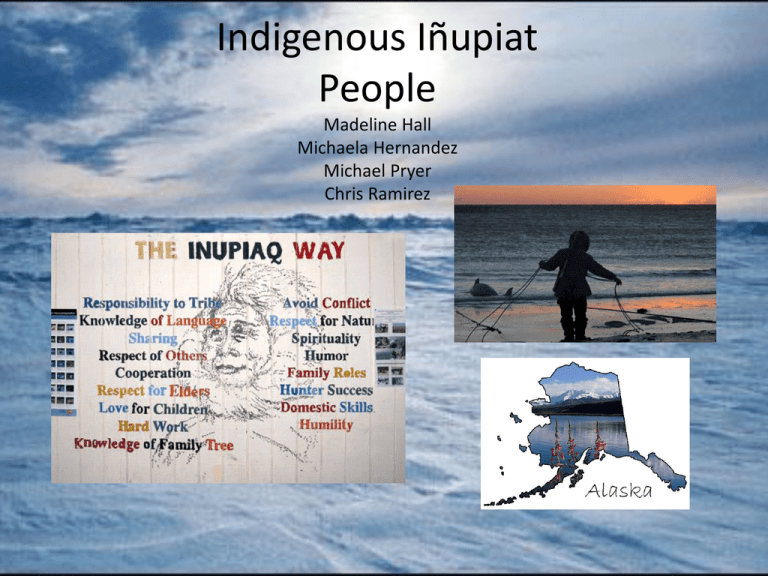
Indigenous Iñupiat People Madeline Hall Michaela Hernandez Michael Pryer Chris Ramirez Iñupiat The name "Inupiaq," means "real or genuine person” • Traditional clothing: outer and inner pullover tops (Parkas ,Kuspuks/qiipaghaq) • Outer and inner pants • Socks, Boots • Tops/Pants=Caribou Skin with fur • Fur faces inside on inner garments, outside on outer garments Where do they reside? • Historically, Inupiat people can be found in North Western Alaska within the artic circle, but they also previously conquered the Circumpolar North(Canada, Siberia, and Alaska). • They are currently located all over the world. 1,820 Bering Strait Inupiat 3,675 Kotzebue Sound Inupiat 1,850 North Alaska Coast Inupiat 1,050 Interior North Inupiat Demographics and Language • Barrow, (population 4,434) and Kotzebue, (3,107), are the region's largest cities where the population is mostly Inupiat Eskimo. • Alaskan Inupiaq includes two major dialect groups: North Alaskan Inupiaq and Seward Peninsula Inupiaq. • Alaska is home to about 13,500 Inupiat, of whom about 3,000, mostly over age 40, speak the language. Houses and Settlement • Traditionally, homes are usually made from sod blocks, laid over driftwood or whale bone and walrus bone frames (dome-shaped). • Usually hold 8 to 12 people Resources • Their lives evolve around the whale, walrus, seal, polar bear, caribou and fish. • Birds and Eggs are important part of diet. Video Iñupiaq Whale Hunt http://www.youtube.c om/watch?v=LAqEK7 K5oCQ Traditional Tools • Variety of stone, wood, bone, and ivory • Bow Drill: starts fires, drills holes • Hunting equipment and tool kits are separate Traditional Transportation • Umiaq is a large open skin boat, 15 25 feet long (carried up to 15 people) • Kayaks • Baset sled • Snowshoes Inupiat Cultural Patterns • Cyclical annual activities and traditions • Winter months with little to no sunlight • Summer activities • Fall harvest and preparations for winter Historically Rural • Traditionally and historically live in arctic tundra and sub-arctic areas • The only plants that thrive are small shrubs and lichen • Mammals that survive on land are compact and stocky to retain heat Western Contact Poverty & Wealth • Pre-contact Inupiat societies were stable with their own economic structure • Post-contact Inupiat societies have been impoverished – Social problems – Loss of culture – Apathy Education • Western education ignores traditional Inupiat education and knowledge – Forced ‘special education’ programs – Mind vs. Body • Low motivation to complete education • Lack of tools/finances to go onto college • Urbanized and assimilated youth War and Peace • Historically divided and at war within Inupiat society – Alliance and Conflict by Ernest Burch Jr. – Ten separate nations – Stereotype of docile and submissive Eskimos • Assimilation post-contact Minority Status • Alaska Natives are 15% of the population within Alaska • Inupiaq are only a fraction of this number • With historical and ongoing assimilation culture is disappearing Oppression • • • • • Children forced into boarding school system Missionaries/Christianization Enforced destruction of language and religion Subsistence-restricting laws Forced urbanization/modernization Segregation/Forced Integration • • • • Boarding schools JOM program Separate health care Absorbed into growing urban centers and Missionary towns Darlene Wilson Age 21 Juneau, AK September 2012 WESTERNIZATION URBANIZATION Lack of education Depression Alcoholism Domestic Abuse Racism Many Iñupiat people depend on subsistence living. It is becoming harder to hunt the whales, seals, and walrus that are needed for survival. http://web.worldbank.org/WBSITE/EXTERNAL/TOPICS/EXTSOCIALDEVELOPMENT/0,,contentMDK:21951825~p agePK:210058~piPK:210062~theSitePK:244363,00.html What exist??? Roots in Animism Spirits Supernatural Existence Reincarnation and recycling of spirit Deceased members names given to newborns Animism Natural Physical Entities Christianity Missions Holidays Relationship Reciprocal Responsibility Redistrubtion Respect Elder Care Community Immediate kin Endogamous Kinship ties Umialik Extended family Importance of children Manifest Destiny Global Warming Protestant Missions Qargi club houses North Slope Festival Messenger Feast Qatizut s Sources • http://www.akhistorycourse.org/articles/articl e.php?artID=196 • http://library.thinkquest.org/22550/inupiaq.ht ml • http://www.uaf.edu/anlc/languages/i/
